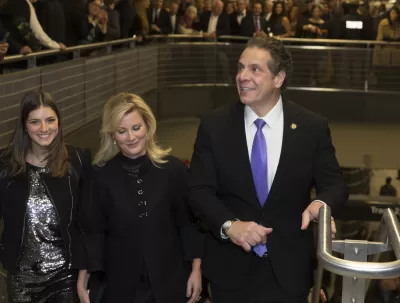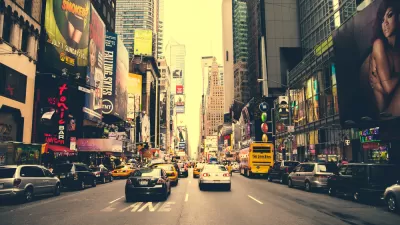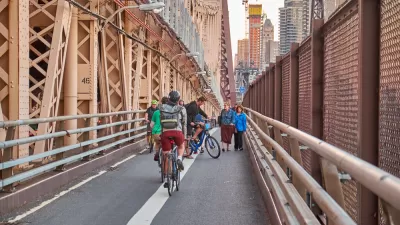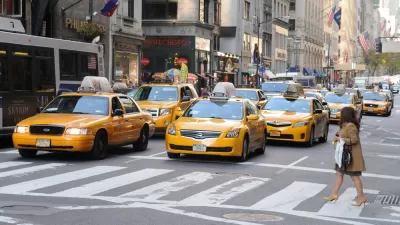Gov. Andrew Cuomo was not an early endorser of congestion pricing. Why the sudden embrace, particularly when Mayor Bill de Blasio is opposed? Turns out that electronic tolling technology, embraced by the MTA, appears to have moved the governor.

[Updated September 6, 2017] Gov. Andrew Cuomo, who celebrated the opening of a new Hudson River bridge named for his late father on Friday, is now tackling four New York City bridges. Rather than rebuilding them, as he did the long-decaying Tappan Zee Bridge between Westchester and Rockland Counties over the Hudson River, he is presumably considering adding tolls to the free East River bridges, an essential part of congestion or cordon pricing plan for New York City that he has yet to put forth. However, he has a formidable opponent in the mayor.
"As debate about creating a toll system to limit traffic in the most congested parts of Manhattan heats up, a transformation in technology could make congestion pricing a far more realistic notion than when it was last proposed a decade ago," reports Marc Santora for The New York Times.
By the end of the year, nine crossings around the city will employ an open-road, cashless collection system that does away with toll booths, toll lanes and toll collectors. Instead, sensors and cameras installed both above the road and in the pavement itself will capture cars and trucks [by photographing their license plates] as they zip by at full speed – automatically charging the 90 percent of drivers with E-ZPass transponders, and billing the other 10 percent by mail.
"Open road tolling streamlines commutes, reduces inconvenience, and, along with bolstered security measures and new LED lighting and art, reimagines New York's crossings as part of our infrastructure overhaul to meet the needs of current and future generations of New Yorkers," stated Governor Cuomo in the Metropolitan Transportation Authority (MTA) press release last December about the conversion to electronic toll collection (ETC). "This project is a transformative investment in our future that revolutionizes statewide transportation and helps us build a new New York."
"Under the old system, about 250 vehicles could pass through the E-ZPass booths per hour; about 850 cars can zip through the new system in the same amount of time," adds Santora
The Golden Gate Bridge dismantled its last toll booth a year ago to complete implementation of "a $3.2 million all-electronic collection system," reported Megan Hansen for the Marin Independent Journal on March 27, 2013. Motorists who lack FasTrak transponders pay $7.75, while those with the transponder pay a dollar less for the inbound toll.
Motorists without transponders will pay a much greater toll in New York than those using E-ZPass. For example, crossing the Verrazano-Narrows Bridge between Brooklyn and Staten Island, the toll-by-mail is $17 vs. $11.52 with E-ZPass. Crossing from the Bronx to Manhattan on the Henry Hudson Bridge, it's $6.00 vs. $2.64.
In the New York metro region, only MTA is proceeding with the conversion to cashless tolling. Crossings controlled by the Port Authority of New York and New Jersey will continue to accept cash due to resistance from NJ Gov. Chris Christie.
If Cuomo adopts the Move NY congestion (cordon) pricing plan, overhead toll gantries would be placed in Manhattan across 60th Street to toll southbound motorists.
Revenue from the plan would be used to boost transit service. Mayor Bill de Blasio opposes the plan, favoring an income tax approach to fund public transit.
[Updated to reflect the correct date for the removal of the Golden Gate Bridge toll booths.
FULL STORY: Open-Road Tolls Could Pave the Way for Manhattan Congestion Pricing

Maui's Vacation Rental Debate Turns Ugly
Verbal attacks, misinformation campaigns and fistfights plague a high-stakes debate to convert thousands of vacation rentals into long-term housing.

Planetizen Federal Action Tracker
A weekly monitor of how Trump’s orders and actions are impacting planners and planning in America.

San Francisco Suspends Traffic Calming Amidst Record Deaths
Citing “a challenging fiscal landscape,” the city will cease the program on the heels of 42 traffic deaths, including 24 pedestrians.

Defunct Pittsburgh Power Plant to Become Residential Tower
A decommissioned steam heat plant will be redeveloped into almost 100 affordable housing units.

Trump Prompts Restructuring of Transportation Research Board in “Unprecedented Overreach”
The TRB has eliminated more than half of its committees including those focused on climate, equity, and cities.

Amtrak Rolls Out New Orleans to Alabama “Mardi Gras” Train
The new service will operate morning and evening departures between Mobile and New Orleans.
Urban Design for Planners 1: Software Tools
This six-course series explores essential urban design concepts using open source software and equips planners with the tools they need to participate fully in the urban design process.
Planning for Universal Design
Learn the tools for implementing Universal Design in planning regulations.
Heyer Gruel & Associates PA
JM Goldson LLC
Custer County Colorado
City of Camden Redevelopment Agency
City of Astoria
Transportation Research & Education Center (TREC) at Portland State University
Jefferson Parish Government
Camden Redevelopment Agency
City of Claremont





























